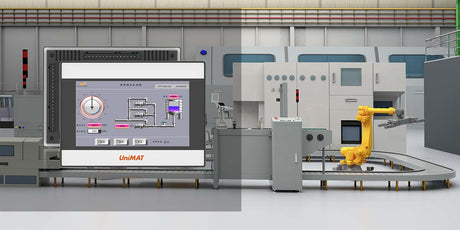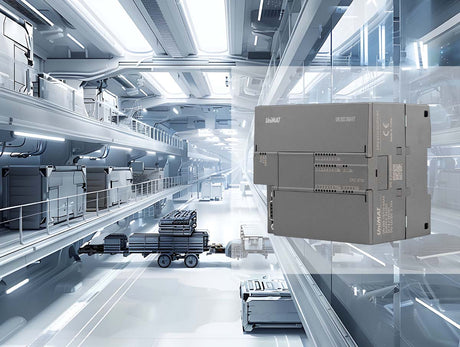1. System overview
The original two engine assembly lines of an automobile engine factory mainly complete the assembly work of the engine. The engine cylinder block from the machine is placed on the pallet of the assembly line by the electric hoisting equipment through the raceway through the assembly of the various workstations, workers in each workstation to install the corresponding parts to the engine cylinder block, the final production line process after the engine assembly into the next process.
2.system survey
automobile engine; automotive engine; motor car engine
assembly line
assembly work; fitter's work; erection work; fitting work
cylinder block; cylinder body,block
wiring; distribution; layout; conductor arrangement
beltline; production line; product line
engine assembly

The whole assembly line works as shown in the picture above. The operator operates the electric crane to hoist the engine cylinder block processed by the machine wire to the pallet of the engine production line. The engine assembly line automatically transfers the pallet to the next installation station counterclockwise through the raceway and automatically stops at the next installation station. In this position, the operator of the installation station installs the corresponding parts to the engine block according to the engine model and sends instructions to the assembly line. The engine tray is automatically transferred to the next station, and the operator of the next station installs the corresponding parts to the engine in turn, and the operator of the next station analogizes the engine to walk when the engine goes. At the off-line station, the operator of the station lifts the installed engine off the engine assembly line through an electric hoisting device to complete the engine production.
The turntable, lifting platform, turning machine and other equipment installed in a certain position on the assembly line can rotate, lift, turn the engine and other operations to facilitate the installation of the operator behind.
3. system requirements
A) Field sensors must be transmitted to the assembly line control system through a communication network through a dedicated collection module with a high IP level.
B) One operating box is installed at each station, and the operator controls the rotation, turning and lifting of the engine tray by the buttons on the operating box to complete the assembly of the engine parts.
C) Each motor requiring positive and negative rotation must be equipped with a positive and negative switching contactor with a mechanical interlocking device and a motor protection switch with auxiliary contacts for each motor.
D) The supply voltage of all control loops must be 24V to ensure the safety of personnel on the production line.
E) on the main control console, you can show the movements of each station motor and pneumatic component. When the fault occurs, there is corresponding prompt information on the main console and through the fault boot program directly into the PLC control program for fault diagnosis.
4. system configuration and function realization
According to the system control requirements, the PLC-300 series controllers of Siemens Company of Germany are used as the main controller of the whole assembly line, the ET200M remote I/O system designed specially for the field operation box is used as the acquisition system of the control signal of the field operation box, and the I/O system with high IP grade of ET200eco is used as the field sensor signal. The acquisition system adopts WinCC human-machine interface software and industrial control unit to build the operation monitoring station of the system.
The assembly line of automobile engine has the following characteristics:
1) control sites are numerous, control signals scattered.
Since an engine has to go through hundreds of processes from cylinder processing to assembly, hundreds of parts are installed. At least one operator in each process installs the corresponding parts, and a separate site is set up to accept the operator's control instructions. The control signal of each station is relatively small, and the average control box has about 10-20 input and output signals.
In view of the above situation, if each signal on the spot is connected to the control system located in the main control cabinet, and the whole production line is controlled by the general centralized distributed control mode, the cable laying cost is too high to meet the transformation requirements. Therefore, the distributed bus control system proposed by Siemens is adopted, and the field I / O control module ET200M is arranged nearby. The collected signal is transmitted to CPU through PROFIBUS bus to realize control, which saves the laying of control cable and saves the cost.
ET200M remote I/O module adopts UniMAT I/O control module UN 300 series, which not only saves cost, but also realizes corresponding functions.
2) on-site sensor signals require access to a high IP level I/O system.
The optoelectronic switching signal installed on the production line adopts the high IP I / O system ET200eco because of the long distance from the access control box. The protection level of ET200eco is IP67, which can be directly installed on the production line without the installation of electric cabinets. The on-site optical and electrical signals are directly connected to ET200eco and transmitted to CPU through PROFIBUS communication network, which saves the trouble of laying cables and reduces the engineering cost.
3)all control points can be divided into four categories, the same category control content is basically the same.
Engine tray generally in the production line to complete the main stop, rotation, lift, flip four actions, the control program must automatically complete each of the above actions, and in the process of execution of the above actions the operator can intervene in the execution of the action at any time.
Stop: The engine stops automatically every time it reaches an assembly station, and releases automatically when the operator issues the release instructions after the assembly. The current operation of the engine can not affect the operation of other engines.
Rotation: In the assembly line, there is a special equipment for rotating engine tray - turntable, when the engine stops automatically when passing through the turntable, turntable rises, rotating 90 degrees or 180 degrees, turntable down, the engine release.
Lifting: There is a special lifting platform at the four corners of the assembly line. The tray is lifted when the engine passes through the lifting platform, and then the roller located on the lifting platform transfers the tray to the next line.
Turn over: Sometimes to install parts at the bottom of the cylinder block requires turning the engine 90 or 180 degrees for installation. When the engine tray passes through the turning machine, the tray is automatically lifted off the production line, the arm of the turning machine drops, the engine is clamped and then rises to a certain height, turning 90-180 degrees down to the tray.
4)Require the engine to complete the movement as automatically as possible in the process of conveying, with little operator intervention to minimize the operator's work intensity.
When the engine tray runs to a work station, it automatically completes the operation of the work station, then stops, waiting for the operator's instructions, the operator completes the assembly work, only need to press a button or step on a switch to complete the current engine release, the next engine assembly, to minimize the amount of relief. The intensity of the operator's work.
5) every motor must be controlled by DC 24V contactor to ensure operation safety.
Due to the large number of equipment on the assembly line, when there is a short circuit, it may seriously affect the operation of other equipment, so all the control signals on the production line are powered by direct current 24V to ensure the safety of various equipment on the assembly line.
6) Each assembly line is equipped with an industrial computer to display the action of all the equipments on the current line. When the equipments fail, it can be displayed in a very intuitive way, and can jump directly to the corresponding control position in the PLC program to facilitate fault query.
An industrial control computer is displayed on each assembly line.

Four use effect analysis
The original control system of the engine assembly line is the Siemens S5 control system. The failure rate of the engine assembly line increases gradually with the use time of more than ten years, and the replacement of spare parts is difficult. After transforming into Siemens S7 CPU + UNIMAT compatible module combination control system, the failure rate is obviously reduced, and the cost is saved. After using for one year, no electrical equipment fails, and the operation rate of equipment is improved to ensure the stable operation of production.









